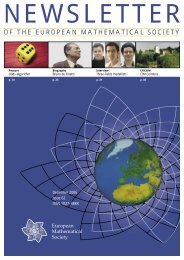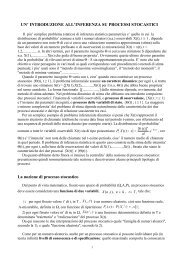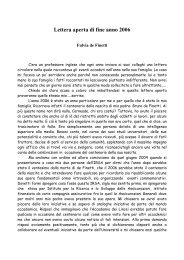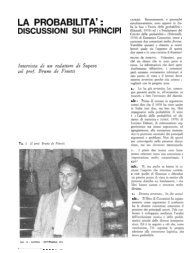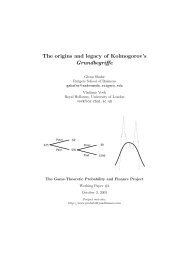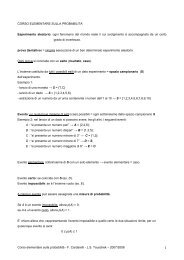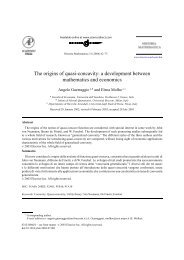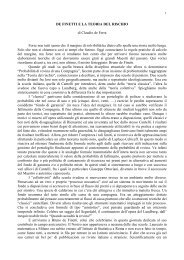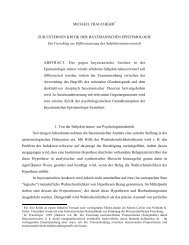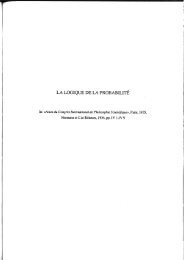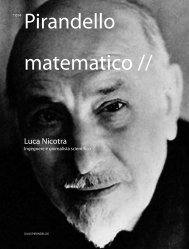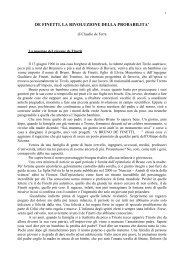Bruno de Finetti e la geometria del benessere
Bruno de Finetti e la geometria del benessere
Bruno de Finetti e la geometria del benessere
You also want an ePaper? Increase the reach of your titles
YUMPU automatically turns print PDFs into web optimized ePapers that Google loves.
MARSCHAK J., Rational Behavior, Uncertain Prospects and Measurable Utility,«Econometrica», vol. 18, 1950, pp. 111-141.PARETO V., Manuale di Economia Politica, Roma, Edizioni Bizzarri, 1965.RAMSEY F. P., A Mathematical Theory of Saving, «Economic Journal», vol. 38, 1928,pp. 543-559.ROSSIGNOLI C., La schiavitù <strong>de</strong>ll’anarchia. Gli scritti di <strong>Bruno</strong> De <strong>Finetti</strong>sull’equilibrio economico, «Economia Politica», n. 1, 1999, pp. 35-64.SAMUELSON P.A., Foundations of Economic Analysis, Cambridge Mass, HarvardUniversity Press, 1983.VON NEUMANN J., MORGENSTERN O. Theory of Games and Economic Behavior, terzaed., Princeton N.J., Princeton University Press (prima ed. 1944, seconda ed. 1947)1953.SOMMARIOLa figura <strong>de</strong>l matematico italiano <strong>Bruno</strong> De <strong>Finetti</strong> (Innsbruck, 1906 - Roma, 1985) haoccupato una posizione di rilievo nell’ambito <strong>de</strong>lle scienze matematiche <strong>de</strong>l Novecento e ciògrazie non solo all’indubbio spessore di matematico, ma anche allo sforzo di applicazione <strong>de</strong>imetodi quantitativi alle scienze economiche e sociali, combinato a uno spiccato interesse per lequestioni filosofiche. Lo studioso è stato <strong>de</strong>finito ‘il padre <strong>de</strong>l<strong>la</strong> corrente neo-bayesiana’,proprio perché ha fornito una interpretazione innovativa <strong>de</strong>l calcolo <strong>de</strong>l<strong>la</strong> probabilità, che si è inseguito imposta nelle scienze statistiche. Gli scritti di De <strong>Finetti</strong> più significativi in tal sensorisalgono al 1931 23 , ove egli introduce <strong>la</strong> <strong>de</strong>finizione di probabilità soggettiva che andava adintegrare il già noto concetto di probabilità oggettiva. La probabilità soggettiva è stata più volteripresa da L. Savage nel suo The Foundations of Statistics, in merito agli assiomi sulcomportamento razionale individuale in condizioni di incertezza (teoria soggettiva <strong>de</strong>ll’utilitàattesa) e ciò testimonia le vaste implicazioni teoriche <strong>de</strong>ll’intuizione di De <strong>Finetti</strong>.Gli scritti di natura strettamente economica sono quantitativamente minori, ma non perquesto meno <strong>de</strong>gni di nota: già a partire dal 1935, lo studioso analizza le possibili applicazioni<strong>de</strong>l<strong>la</strong> matematica all’economia e soprattutto all’economia <strong>de</strong>l <strong>benessere</strong>, che ribattezza«<strong>geometria</strong> <strong>de</strong>l <strong>benessere</strong>»; in essa approfondisce problematiche di efficienza ed equità,criticando il concetto di ottimo paretiano. Come sostenitore <strong>de</strong>ll’operazionalismo, <strong>la</strong> correnteche si diffon<strong>de</strong> proprio in quegli anni fra gli studiosi di varie discipline, De <strong>Finetti</strong> parte dalleosservazioni per <strong>de</strong>terminare una misura soggettiva <strong>de</strong>ll’utilità.PAROLE CHIAVE: <strong>Bruno</strong> De <strong>Finetti</strong>, probabilità soggettiva, economia <strong>de</strong>l <strong>benessere</strong>.ABSTRACTThe figure of the Italian mathematician <strong>Bruno</strong> De <strong>Finetti</strong> (Innsbruck, 1906 - Roma, 1985) hasp<strong>la</strong>yed a crucial role in the mathematics of XIX Century, especially thanks not only to hisundoubtedly skills in mathematics, but also because he tried to apply the quantitative methods toeconomics and social sciences in general. He was also fascinated by philosophical questions,another particu<strong>la</strong>r feature of his eclectic mind. He was <strong>de</strong>fined the ‘father of neo-Bayesiancurrent’, due to his innovative subjective interpretation of probability. The major works of De<strong>Finetti</strong> in which he exp<strong>la</strong>ined for the first time his particu<strong>la</strong>r view of probability were written23 “Probabilismo. Saggio critico sul<strong>la</strong> teoria <strong>de</strong>lle probabilità e sul valore <strong>de</strong>l<strong>la</strong> scienza”, Logos (Biblioteca diFilosofia, diretta da A. Aliotta), Pezzel<strong>la</strong>, Napoli, 1931, pp. 163-219 e “Sul significato soggettivo <strong>de</strong>l<strong>la</strong> probabilità”,Fundamenta Mathematicae, 17, 1931, pp. 298-329.22




